
Euphorbia is a very large and diverse genus of flowering plants, commonly called spurge, in the family Euphorbiaceae. "Euphorbia" is sometimes used in ordinary English to collectively refer to all members of Euphorbiaceae, not just to members of the genus.

Pachypodium is a genus of succulent spine-bearing trees and shrubs, native to Madagascar and Africa. It belongs to the family Apocynaceae.

The Aizoaceae, or fig-marigold family, is a large family of dicotyledonous flowering plants containing 135 genera and about 1800 species. They are commonly known as ice plants or carpet weeds. They are often called vygies in South Africa and New Zealand. Highly succulent species that resemble stones are sometimes called mesembs.

Stapeliinae is a subtribe of flowering plants within the tribe Ceropegieae of the subfamily Asclepiadoideae of the family Apocynaceae. The subtribe comprises about 35 genera, including both the stem-succulent "stapeliads" and the horticulturally popular genera Brachystelma and Ceropegia. The largest number of genera are native to Africa, but a more limited number of genera are widespread in Arabia and Asia. Historically, a similarly circumscribed taxon was treated as a separate tribe, Stapelieae.

Euphorbia maritae is a species of perennial flowering plant in the family Euphorbiaceae. It takes its name from the discoverer, Marita Specks, who collected the first known specimen in Tanzania with her husband Ernst Specks in 1999.

Euphorbia arbuscula is a species of plant in the spurge family (Euphorbiaceae). It is endemic to the archipelago of Socotra in Yemen. Its natural habitats are subtropical or tropical dry forests and subtropical or tropical dry shrubland.
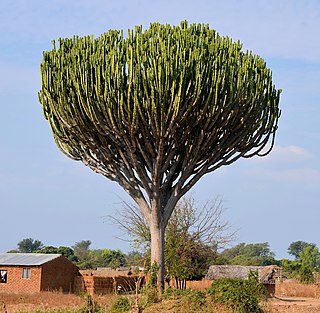
Euphorbia ingens is a species of flowering plant in the family Euphorbiaceae. It is native to dry areas of southern Africa. It is popularly known as the candelabra tree or naboom. Its milky latex can be extremely poisonous and is a dangerous irritant.
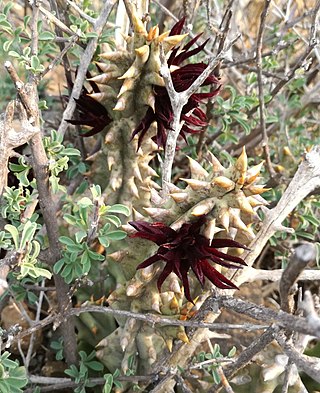
The genus Quaqua falls within the tribe of plants known collectively as stapeliads. All stapeliads, including Quaqua, are Old World stem succulents.

Portulacaria afra is a small-leaved succulent plant found in South Africa. These succulents commonly have a reddish stem and leaves that are green, but also a variegated cultivar is often seen in cultivation. They are simple to care for and make easy houseplants for a sunny location. In frost-free regions they may be used in outdoor landscaping.

Stapeliopsis is a genus of succulent plants in the family Apocynaceae, native to southern Africa.

Piaranthus is a succulent plant genus in the subfamily Asclepiadoideae, in the family Apocynaceae.
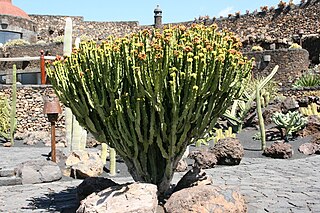
Euphorbia abyssinica, commonly known as the desert candle or candelabra spurge, is a species of plant in the family Euphorbiaceae. E. abyssinica is endemic to Ethiopia, Somalia, Sudan and Eritrea. It was first described in 1791, by the German botanist Johann Friedrich Gmelin. In its native habitat, it can grow up to 10 m (33 ft) tall. The woody stem is used for firewood and as timber in roofing, furniture and other items, and the sap is used in traditional medicine. It is also cultivated as an ornamental house plant.
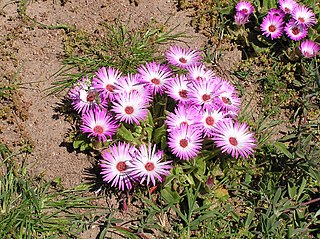
Dorotheantheae is a small tribe of annual succulents in the Aizoaceae subfamily Ruschioideae. Though it originally comprised three genera, Cleretum remains as the only recognised genus. Dorotheantheae are endemic to the western and south-western parts of South Africa. The type genus is Dorotheanthus, despite it being no longer recognised.

Duvalia elegans is a small succulent plant species, in the family Apocynaceae. It is the type species of the genus Duvalia, and it is endemic to the Western Cape Province, South Africa.
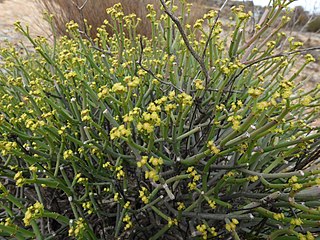
Euphorbia rhombifolia is a species of flowering plant in the Euphorbiaceae family. It is native to Namibia and South Africa, where it is widespread in clay-rich soils, extending as far east as Kwazulu-Natal.
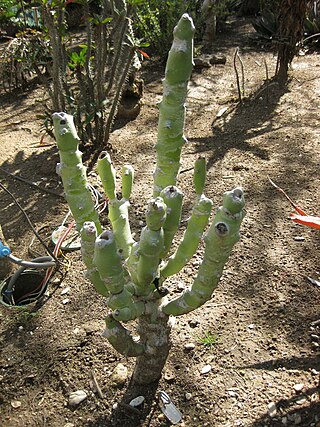
Euphorbia caducifolia is a subtropical succulent species of flowering plant in the family Euphorbiaceae. It is found in the arid regions of northwestern Indian subcontinent. In India it is known as the leafless milk hedge.
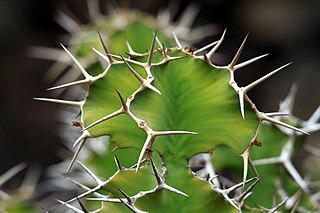
Euphorbia grandicornis, the cow's horn plant, is a succulent plant of the Euphorbiaceae or spurge family. It is native to the KwaZulu-Natal province and the Northern Provinces of South Africa and to Mozambique and Eswatini.

Euphorbia longituberculosa is a species of flowering plant in the family Euphorbiaceae, endemic to the Arabian Peninsula and North-east Africa. It inhabits rocky terrain, sheltered among stones or under small shrubs; from sea level to 1,800 m (5,900 ft).



















